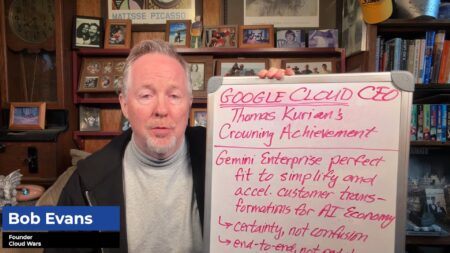In this Acceleration Economy Lightning Strike, Bob Evans and Tony Uphoff discuss a recent survey, conducted by the analyst firm Gartner, that gathered responses on the top objectives for CEOs. The firm’s analysis of the survey concluded that customers and supply chains were the lowest on the list of priorities, while growth took the lead as the most important objective for CEOs. In the interview, Tony and Bob discuss why they found the order of these priorities baffling and not particularly useful for those leading organizations today.
Highlights
00:56 – Tony says that the recent Gartner Symposium featured a cornerstone presentation on the top issues for CEOs and how business objectives relate to technology, areas of focus, and dynamics. He says the “logic flow” of this presentation focused on the surveyed perspectives and objectives of CEOs that would then presumably be shared with the CIOs and CTOs of their organizations. The presentation featured an analysis of the survey done by Gartner analysts.
02:27 – Out of 12 overall, the top objective noted by the surveyed CEOs was growth. The Gartner survey analysis also concluded that growth as an objective is declining. Tony says he was surprised to find that products and customers ranked in sixth place as top CEO objectives. Similarly, only 6% of survey respondents listed supply chain and customers as top objectives, placing the two categories in 11th and 12th place on the list.
04:48 – While Tony says that Gartner is made up of “smart folks” and that it has “built a nice business,” but he thinks that “analyst firms shouldn’t be beyond analysis and criticism.” The survey’s relative de-emphasis on customers “defies logic” and reflects the lack of understanding about the motivations of the technology purchasing process. Instead, the survey should have focused on the issue of the business and technology worlds’ drastic changes and how vendors need to respond to them. Every CEO today has a growth mandate, but growth is directly tethered to an organization’s ability to harness technology, which is a significant shift from five or more years ago, when the singular focus was on areas of efficiency and how technology could help in that regard. Almost 90 percent of technology today is delivered as a service, so it’s more important today to know why companies are buying technology, how they’re buying it, and how vendors need to respond to the buying process. We’ve from a tech-centric world to a customer-centric world. Technology vendors need to “get into the mind of their customer who is trying to grow their business.” They’re no longer interested in a simple automation or only areas of efficiency.
07:32 – Tony adds that there has been a demographic shift, and as technology becomes more of a revenue-driving dynamic, more business unit folks and people who have P&L responsibility are demanding technology resources.
08:14 – Bob says that Tony has an understanding of how CEOs think about technology because he just “concluded a stint as a CEO” for five and a half years, in which he was able to enact a “total transformation of a company from one industry to another” before selling it to a public company.
08:50 – Tony says that CEOs who are not company founders are usually brought in to fix something. Over the last 25 years of his career, he has found that typically the “top one or two levers” available to CEOs to transform the fortunes of a company are technology and people. The only way to develop new products and dazzle customers is through working with “fantastically innovative” people and harnessing the power of technology.
10:10 – As it relates to the analysis presented at the Gartner Symposium, Bob says he is “puzzled by this survey.” How can customers be priority number 12 on a list of 12?
11:12 – To Bob’s point, Tony says the results seem asynchronous and is unsure how it “lines up.” Survey instruments are “at the whim and fancy” of who is being sampled and how they are being sampled. Tony thinks that maybe the sample for this survey was relatively small. The core issue is that the “intellectual capital” that Gartner is putting into the market serves as a proxy for where the market is going. In Tony’s opinion, this survey ultimately raises more questions than it answers. Tony and Bob have spent their careers building information and analyst data products for professional marketplaces. As a result, Tony says that the Gartner analysis “was particularly tone-deaf.”
12:43 – Acceleration Economy’s approach is an intense focus on growth as an ideal outcome, and the reason technology is such a big part of the focus is because it’s what businesses are demanding today. It’s important to establish a link between the technology-purchasing process and the marketplace’s demand for it, which brings it back to the importance of dazzling customers rather than putting customers as number 12 on a list of 12 CEO priorities.
14:25 – Tony echoes Bob’s remarks on Acceleration Economy’s approach to growth as the top objective and adds that the Acceleration Economy team takes a practitioner-led view of technology as a means of transforming a business, which “creates a more visceral and relevant connection with buyers.”
17:20 – Bob asks: “What are your top three priorities on a list for a CEO in 2022?”
17:26 – Tony says he would place growth on the top of his priority list as an “umbrella statement” -with customers as the number one thing that he looks at. That said, the idea of growth as a priority is “so obvious” that he “would not even think to respond to that in a survey.” Leaders have a mandate to grow a business, so customers should be placed on top of the list because growth is implicit. Second, distribution, supply chain and logistics – depending on the industry of course – should be at the forefront of priorities, with technology as the answer. Lastly, the co-creation of value through partner ecosystems should be considered a top priority.
Register here for your on-demand pass to view all content from Partners Ecosystem Digital Summit. The digital event, which took place on April 20, focused on analyzing the business and IT imperatives around cloud, AI, automation, data modernization, and cybersecurity that define the future of partnerships.









